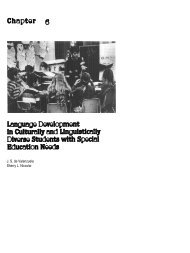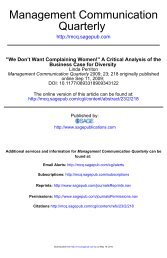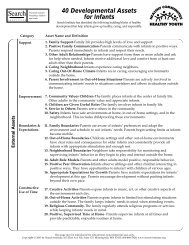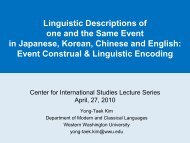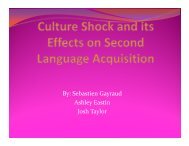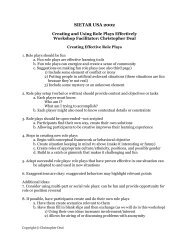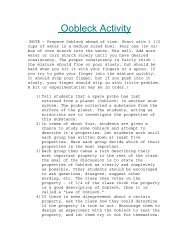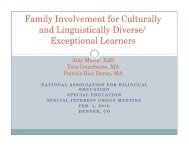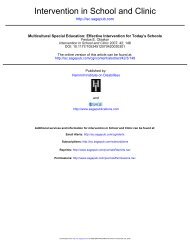Assessment of Culturally & Linguistically Diverse Students
Assessment of Culturally & Linguistically Diverse Students
Assessment of Culturally & Linguistically Diverse Students
You also want an ePaper? Increase the reach of your titles
YUMPU automatically turns print PDFs into web optimized ePapers that Google loves.
Today I am going to put assessment <strong>of</strong> English Language Learners in thespotlight. Being teachers <strong>of</strong> a second language, some <strong>of</strong> this information,especially on assessing language pr<strong>of</strong>iciency, may be familiar to you. In ourclassrooms most <strong>of</strong> us have CLD or culturally and linguistically diversestudents. Although a student may not receive ELL services or maybe neverhas, if you have students who are bilingual, their first language will impact theirsecond in some way.1
In this presentation I will explain some terminology related to the field <strong>of</strong>Teaching English as a second language. I will also talk about how schoolsidentify these students, determine their level <strong>of</strong> pr<strong>of</strong>iciency in English and theirfirst language, how schools and teachers can track their progress in gainingpr<strong>of</strong>iciency and in their acculturation. I will also talk about how to identify astudent in your class who might be exited from an ELL program, sinceBellingham High School does not <strong>of</strong>fer an ELL program. We have studentswho were formally ELL students t or have a background in another language.You will see the L1 influence on L2 as a rule in your classroom with yourmonolingual English speakers learning L2. Therefore some <strong>of</strong> this informationmay be applicable to your mainstream, English speaking students. There aremany parallels and similarities between English language learners andmainstream English speakers learning L2. There are obviously manydifferences between those two groups. Your mainstream English speakers aresurrounded by the same type <strong>of</strong> student and are <strong>of</strong> the dominant culture. Theydo not face acculturation issues and have had years <strong>of</strong> academic training intheir first language. Those cognitive learning strategies and skills will transferto the L2. Whereas the ELLs may not have had any academic experience intheir native language before beginning to learn their L2 (English) andacademic skills. I will talk about best practices in trying to asses CLD studentsin our classrooms. Many <strong>of</strong> these methods and strategies you already may useif you are teaching a World Language or simply trying to teach to variedcognitive learning styles. I view many <strong>of</strong> the informal assessment strategiesthat I will mention later as simply good teaching practices.2
A culturally and linguistically diverse student is exposed to a language and / orculture in his or her home environment that is not the mainstream or dominantculture. This could be a student who has grown up bilingually or monolinguallyin a language other than English. The student could be an immigrant orrefugee from another country or be U.S. born. The student and his family mayspeak dialectical or a non-standard form <strong>of</strong> English. Some educators andresearchers prefer the term English “vernacular” rather than non-standard, asnon-standard d has negatives connotations. ti These students t <strong>of</strong>ten showdifficulties in speaking, reading, writing, and understanding English in anacademic and / or social environment. This group <strong>of</strong> students is very diverse,from varied language and cultural backgrounds. Each has different levels <strong>of</strong>pr<strong>of</strong>iciency in his or her first language and English. At Bellingham High, we seestudents we know as CLD speaking English fluently with English-speakingpeers. They are fluent, using slang, and they seem to be equally capable inboth languages. The reality is that they may appear pr<strong>of</strong>icient in English and /or their native language, but this may be only a surface understanding. JimCummins, an expert on minority languages, bilingualism, and assessmenttermed this surface understanding as BICS. BICS is an acronym for BasicInterpersonal Communication Skills. These culturally and linguistically diversetudents may not demonstrate a deeper “conceptual linguistic knowledge”(Cummins, 136) now commonly referred to as CALP – Cognitive AcademicLanguage Pr<strong>of</strong>iciency. To achieve CALP, students must be able to manipulatethe language in “decontextualized academic situations.” (Cummins, 137). Thismeans speaking in the abstract, without visual representations <strong>of</strong> words andtalking about ideas.3
Here is a visual representation <strong>of</strong> the two kinds <strong>of</strong> acquired pr<strong>of</strong>iciency coinedby Cummins. As you see here, both L1 and L2 are represented. It is importantto know that the level <strong>of</strong> development in L1 impacts and helps develop the L2.So if a student has had academic experience in L1, whether formal schoolingor training at home, there is transference to L2, making the academic learningprocess easier. For example being able to read in L1 has huge implications fortransference to L2. As one other student in my class said in his presentation“you only have to learn to read once.” In a World Language class that t isapparent to us. We are able to use reading as a tool for building vocabulary assoon as students enter our classrooms. The research has shown that bilingualeducation is extremely benefical to the future academic success <strong>of</strong> ELLs.Many believe that bilingual education delays the acquisition <strong>of</strong> English(Rhodes, et. al, 38) Many do not understand the advantages <strong>of</strong> bilingualeducation and advocate English immersion. If a child is able to developacademic skills in his or her home language there will be large amounts <strong>of</strong>transference <strong>of</strong> academic skills as she or he learns English.4
There are several terms you have heard either in meetings, lectures, or articles, which refer to studentsfor whom a language other than English impacts their linguistic skills. NNS is non-native native speaker. ELL isEnglish Language Learner. This term has been used to describe programs and students, i.e. “there isno ELL program at Bellingham High School, even though there are ELL students.” This label is preferredby some because it does not focus on a student’s limitation. (Hargett, 1) ESOL is Englishspeakers <strong>of</strong> other languages. LEP is Limited English Pr<strong>of</strong>icient. This is a term, which,according to Hargett <strong>of</strong> Northwest Regional Education Laboratory, defines the student in terms <strong>of</strong> hislimitations. I have seen this term more in articles and research related to the topic <strong>of</strong> Teaching English asa Second Language. <strong>Students</strong> either learning English or another language in schools could be describedas Second Language Learners (or third language learners if they are learning a World Language andalready are ELLs). TBIP transitional bilingual instructional program is a term I found in somedocuments published by OSPI and the Washington Institute <strong>of</strong> Public Policy Research.5
Finally the term “bilingual” seems to be a catch all. It seems that every individual has adifferent idea about what bilingual means. Obviously it implies that a person is able tocommunicate in two languages, but to what degree? I am <strong>of</strong>ten asked if I am bilingual inEnglish and Spanish. I have always said no in the past. For me, it has always meant more orless equal ability in two languages in speaking, reading, writing, understanding—all forms <strong>of</strong>communication. I know that my dominant language is English, although I am very fluent inSpanish. <strong>Students</strong> can have varying degrees <strong>of</strong> pr<strong>of</strong>iciency across both languages. They canhave sequetional vs. Simultaneous bilingualism. Sequential means that L1 was used before L2(<strong>of</strong>ten when starting school). Simultaneous usually refers to someone who developed bothlanguages at the same time (one parent speaking each), Elective bilingualism is when astudent or his family chooses to learn L2. Circumstantial bilingualism is the result <strong>of</strong>immigration – learning another language in order to survive. The degrees in pr<strong>of</strong>iciency acrossboth languages can be determined by various standardized pr<strong>of</strong>iciency tests determine thelevel <strong>of</strong> bilingualism in students. There is a continuum developed by Woodcock Munoz with 5levels <strong>of</strong> pr<strong>of</strong>iciency: negligible, very limited, limited, fluent and advanced. This is in the oraland reading/writing domains. You could have a scenario such as a student who is 10 years oldand has had 5 years <strong>of</strong> schooling in her native country, could be advanced in oral, reading, andwriting skills in L1 but very limited in English. There could be a student who is fluent in oralSpanish but very limited in reading/writing. At the same time he might be limited in English oralproduction but negligible in the reading/writing domain. There are many combinations.Sometimes there is a student limited to neglibile in both languages, which means that she hasnot received enough instruction in L1 to develop it and has not had sufficient instruction todevelop English skills either. (Rhodes, 140)6
According to the OPSI website a low level <strong>of</strong> pr<strong>of</strong>iciency in English impactstheir learning in a regular classroom. Each state has their own definition <strong>of</strong>LEP, and it is important to know how one’s state identifies these students – themethods, tests, and tools.Most Washington schools provide ESL instruction for ELL students. Bilingualprogramsrequire a school district to enroll sufficient numbers <strong>of</strong> ELL students in thesame grades,speaking the same language, and with similar language pr<strong>of</strong>iciency levels.Theseconditions are rare among Washington schools, particularly at the secondarylevel.While the majority (66 percent) <strong>of</strong> TBIP students speak Spanish, more than160 differentlanguages are spoken in Washington schools. (Pennucchi, 1)Washington’s statute sets a three-year target for students to exit from ELLprograms, but the ultimate criterion for program exit is achieving a certainthreshold on standardized language (WLPT) or academic (WASL) assessmenttests.7
How do we use assessment for CLD students. We use it to identify whopossible ELL students are. We assess their level <strong>of</strong> pr<strong>of</strong>iciency in English andhopefully their first language as well, to determine if they should receiveservices and where to place them. Annually they are tested to determine ifthey should continue services or leave the program. We use ongoing testingthroughout the year to tailor our teaching to meet the students needs and trackprogress. Finally we use some accomodations in our classrooms to helpstudents t overcome linguistic i challenges in demonstrating ti understanding di <strong>of</strong>content.8
It is important to identify a prospective ELL student right away when they enterinto the district, as State Law mandates that they be tested with the WLPTwithin 10 days <strong>of</strong> starting school. To screen in advance, families can be giventhe Home Language Survey provided on the OSPI website. While it is notmandatory, school personnel must ask the following two questions: Is thereanother language spoken in the household? and what is the child’s firstlanguage? All students who answer "yes" to question #2 on the HomeLanguage Survey: “Does your child have a first language other than English?”take the WLPT Placement Test.(OSPI) Also Native American students areconsidered possible ELLs and are eligible to take the test. The WLPTdetermines English language levels and student eligibility for English languageservices. Currently, this is the only assessment <strong>of</strong> reading, writing, speaking,and listening knowledge and skills used in Washington State for Englishlanguage pr<strong>of</strong>iciency for English language learners (ELLs). The PlacementTest is used to determine initial English language levels and student eligibilityfor ELL services. The placement test must be given to a student within 10 days<strong>of</strong> starting school in a district (State Law). The test is to test English pr<strong>of</strong>iciencyonly so therefore would not be a tool to determine Special Educationplacement, only ELL placement. The WLPT annual test is given each year todetermine if the student is still eligible for ELL services. That test or scores onthe WASL will determine if a student is eligible for exiting the program.9
Under Federal Law, English language learners must be assessed annuallywith a standards-based, statewide English language pr<strong>of</strong>iciency test thatincludes speaking, listening, reading, and writing. This information can giveteachers and support staff valuable information regarding a student’s progressfrom year to year. (Gottlieb, 62)Ideally, the test will show pr<strong>of</strong>iciency in BICS and CALP skills. Many <strong>of</strong> thesetests measure BICS and CALP pr<strong>of</strong>iciency in language g and cognitive ability.Some tests measure these skills in both English and a student’s nativelanguage. This might determine whether it is appropriate for a student todevelop their native language as well. In our district, we do not have a bilingualeducation program so there is not the option for bilingual students.In general, the tests which are administered to a student depend on the statewhere the student resides, the services <strong>of</strong>fered in the district, and what isbeing assessed. Many tests have and are being developed now to testbilingual students in a less culturally and linguistically biased way, however, itis very difficult to develop a test to accommodate all the relevant variables <strong>of</strong> aCLD student, such as acculturation, the level <strong>of</strong> bilingualism (pr<strong>of</strong>iciency ineach language g and how one affects the other in communicative skills).Bilingual testing is an emerging field and changes are happening in themanner <strong>of</strong> testing. (Rhodes 166).Besides the WLPT in our state, there are many other standardized tests thatare given to refer and place ELL students. Some <strong>of</strong> these tests measure onlyEnglish pr<strong>of</strong>iciency while others attempt to measure bilingual pr<strong>of</strong>iciency10
I thought that the pr<strong>of</strong>iciency scale might remind you <strong>of</strong> the one we use inWorld Languages.12
Gary Hagget <strong>of</strong> the Northwest Regional Educational Laboratory wrote a paper discussing thepurposes <strong>of</strong> testing in bilingual education and ELL. He has five suggestions for considering thetools and strategies available for language pr<strong>of</strong>iciency testing.Testing should be fair not based on the examiner’s personal judgement. It must measure his orher true ability not what an evaluator thinks she or he can do. That will undermine the test andpossibly penalize the student by failing to identify him for services.If possible it is a good idea to test a student in her native language. Just because a student isnot pr<strong>of</strong>icient in English does not mean that she is pr<strong>of</strong>icient in her home language. Englishcould be the stronger language even if it is not advanced, and both need to be developed.Testing cognitive skills in the native language is also useful for identifying students for specialeducationIt is important to use a variety <strong>of</strong> testing strategies, not just standarized tests. There is a pushfor using more authentic assessments. The standardized tests might help for referral orplacement, but would not be very useful in determining day to day instructional strategies.Conversely, tests that provide a wealth <strong>of</strong> information regarding an individual’s skills would notwork for communicating the ELL population’s progress to a public audience.Another suggestion is to enlist help from district specialists to interpret data, because they arelegally required to identify, monitor and provide services to ELL students.Finally, remember that LEP does not mean that a student is unable to learn, but it means thatthe students cannot demonstrate his or her ability in English.14
In our school environment in Bellingham, ideally we would all know if ourstudents are LEP when the come to our classrooms. However, we are notnotified <strong>of</strong> a student’s status in this area. In our daily lessons andassessments, we notice certain patterns in their speech, writing, and reading.We also notice a surname that is not derived from English or an accent. Atmeet the teacher night, we might speak to the parents and realize that there isanother language at home. One way to follow up with our students is to utilizea resource that t could give us valuable information: the student’s t’ file.15
Review <strong>of</strong> student records is a simple, yet underused way <strong>of</strong> finding outinformation about possible ELL students or any student in your classroom. In astudent’s file you can find the information about the pre-referral process forELL programs, their pr<strong>of</strong>ciciency in English upon entering the school and aslong as they were part <strong>of</strong> an ELL program. You will also find exit information (orlack there<strong>of</strong>) which may indicate that they were exited too early or fell throughthe cracks changing schools.16
There is a movement toward more informal and authentic assessment in manycurricular areas, including ELL classrooms. Some ideas to use in an ELLclassroom might be to test pr<strong>of</strong>icency in conjunction with a standarized test, touse classroom observation <strong>of</strong> tasks and skills that a student can perform anduse a rating system or checklist to assess pr<strong>of</strong>iciency. One tool that I havelearned this semester is the SOLOM – student oral language observationmatrix. It is an informal rating tool to assess and track LEP students. It can beused to group students t and identify instructional ti areas needing more attention.tiIt is sometimes used to identify LEP students’ eligibility for entry or exit fromELL services. When you see the grid you might notice some parallels betweenthis and the ACTFL pr<strong>of</strong>iciency levels. There are two other rating scales whichI learned about his semester, CLIC is classroom language interactionChecklist. This is a checklist <strong>of</strong> very specific linguistic and academic skills thata student demonstrates in class, in both his first and second languages. TheAQS is the Acculturation Quickscreen. This tool measures the level and rate <strong>of</strong>acculturation <strong>of</strong> a student and helps predict whether a student will experienceculture shock.Analytic teaching identifies what teaching strategies are most effective for aparticular student. You identify the baseline performance, create an activitythat will assess the students problem(s), identify steps necessary to completethe activity, construct a sequence and checklist for the student to complete,create a lesson to incorporate the steps and sequence, observe the studentduring the activity noting the results. Student self analysis, analyze results andselect a new area to work on.17
This rubric or rating tool is used to rate language skills in various areas. It isvery similar to tools we use in World language classrooms.18
Federal Laws (IDEA 97; 2004, NCLB) mandate that children cannot bedetermined eligible for services solely based on limited English pr<strong>of</strong>iciency orlack <strong>of</strong> instruction in reading or math. There is sometimes a fine line and it ishard to determine whether a student’s lack <strong>of</strong> academic progress is due tolimited English Pr<strong>of</strong>iciency or a learning disability. Confounding further thisproblem is the question <strong>of</strong> acculturation. There are stages through whichstudents pass when they are recent immigrants, and at a point a student maybe at risk for culture shock. Culture shock which h manifests itself as anxietyupon entering a new culture when one’s coping and problem solvingmechanisms do not work. Disorientation, stress, anxiety and fear are somebehaviors and emotions associated with culture shock. (Schumann). In theclassroom these characteristics <strong>of</strong> culture shock may look similar to the redflags that occur when a student has a learning disability or behavioral disorder.There are many issues surrounding the placement <strong>of</strong> ELL students into specialeducation programs. Across the country there is a disproportionate number <strong>of</strong>LEP students in Special Education Programs. They can be overrepresented,under-identified or mis-identified for special education services. (Hoover) Manyschool psychologists and other personnel are not trained to assess LEPstudents. The problem may lie in three areas: the inadequately trainedexaminers, inappropriate assesessment tools and administration, and failure tocomply with federal and/or state guidelines. (Rhodes, 31) Some examples <strong>of</strong>things that occur are cognitive tests that are administered in English. Theremay be no measure or comparison <strong>of</strong> pr<strong>of</strong>icency in L1 and L2. Sometimes aninterpreter is used, but the interpreter rarely has training in test administration.The fewer students in a language group in a school district, the more likelythere is to be a lack <strong>of</strong> trained personnel and resources in that language.19
OSPI has much useful information regarding ELL students and strategies forteaching and testing. I also found information on the equivalent <strong>of</strong> OSPI inother states as well. Some states may be more savvy on these matters givena larger number <strong>of</strong> ELL students, although in other states with large numbers,there is a backlash and they have gone backwards, such as in California andArizona.20
I will distribute this list <strong>of</strong> resources that are helpful in learning more about ELLstudents, programs, and practices. I have found many ESL / TESL sites on theinternet useful to get ideas for teaching World Language. There are manyterrific techniques and simple teaching ideas to be discovered, such as GLADor sheltered instructional strategies.21
Throughout this course I have learned about many interesting and usefultheories and practices surround English Language Learners and SecondLanguage Acquisition. The articles and books that I read about assessmenthad some great ideas for using varied strategies and differentiatingassessment. It seems like it will be difficult to implement because <strong>of</strong> thenumber <strong>of</strong> students we have in our classrooms but it be a worthy cause to try.In conclusion I would like to reiterate that we assess CLD students to identifythem in the first place, find out their level <strong>of</strong> pr<strong>of</strong>iciency to refer and place themin ELL programs, we use standardized and informal means to track progressfrom year to year and throughout the each year in our class. We need to useassessment to plan our next steps in teaching. <strong>Students</strong> can be exited fromELL programs upon showing pr<strong>of</strong>iciency on the WLPT or WASL assessments.When we do asses, we should use a wide variety <strong>of</strong> tools and strategies.Finally, when CLD student is not learning although she is trying, we need toexamine our teaching first, not assume that they have a disability. How can wecreate teaching strategies and scaffold instruction to meet the needs <strong>of</strong> ourstudents?22



